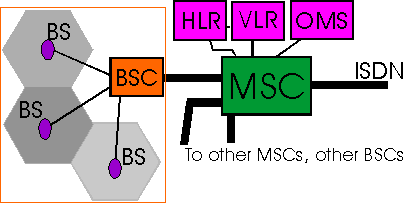
 |
Wireless Communication
Chapter: Network Concepts and Standards
|
Two different solutions have come up. US cellular network operators are implementing a narrowband TDMA version of AMPS, known as IS-54. Meanwhile, the Californian company Qualcomm promotes a CDMA concept, presenting scientific and experimental evidence to academic fora about the technical superiority of CDMA over TDMA. Experimental CDMA systems are in operation in several cities, based on the IS-95 standard. Expectations are that AMPS product shipments reached its top in 1996 with Motorola, Nokia, NEC and Ericsson dominating the market. Digital systems including PCS are expected to become cost effective with analog AMPS in the time frame 1997-2000.
PCS: AMPS 1900
A 1900 MHz version of AMPS has been developed, which allows dual-band/dual-mode 800/1900 MHz systems.
It allows operators to provide identical PCS applications and services in both bands. Seamless inter-working between 800 and
1900 MHz networks is possible through dual-band/dualmode mobile stations.
Subscribers on a D-AMPS 1900 channel can handoff both to/from a D-AMPS channel on
800 MHz as well as to/from an analog AMPS channel.
Existing 800 MHz D-AMPS operators can use the 1900 MHz spectrum to increase capacity and develop new user segments in their 800 MHz networks. For example, 800 MHz cells can provide wide-area coverage (through macro-cells) and act as umbrellas for 1900 MHz micro- and picocells. The small cells can cover the indoor office environment, shopping malls, airports and hot spot coverage. The umbrella cells would carry the signals for fast-moving subscribers and fill in gaps in between two isolated microcells.
D-AMPS 1900 mobile phones will be marketed initially in single-band 1900 MHz as well as dual-band 800/1900 MHz versions. In the long run, dual-band versions may prove themselves able to replace single-band versions at both 800 and 1900 MHz.
AMPS Network Layout
 The D-AMPS 800/1900 system architecture is similar to most other cellular system architectures (e.g. GSM network architecture). It contains a Switching System, an Operation and Support System, base stations and
mobile station.
The D-AMPS 800/1900 system architecture is similar to most other cellular system architectures (e.g. GSM network architecture). It contains a Switching System, an Operation and Support System, base stations and
mobile station.
The Switching System contains five main functional entities:
The Base Station is the radio equipment needed to serve each cell in the network. One base station site may serve more than one cell.
The Operation and Support System supports operation and maintenance activities in the network to allow for reliable and cost-efficient operation.